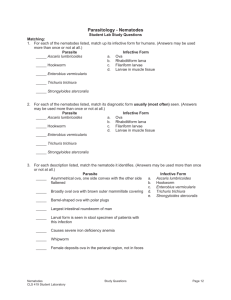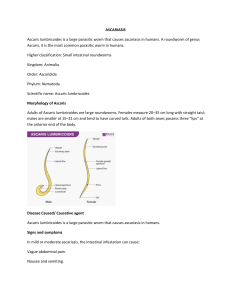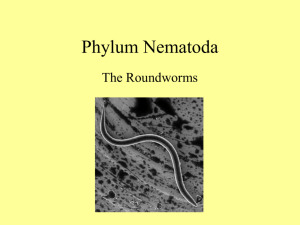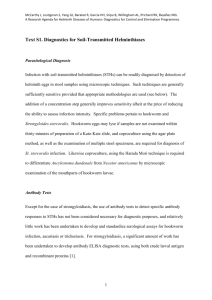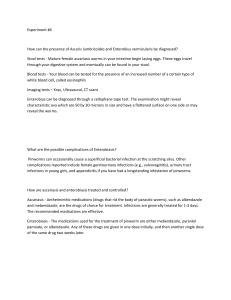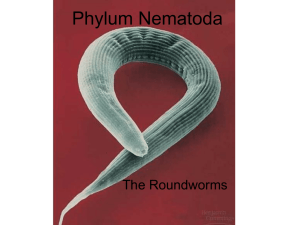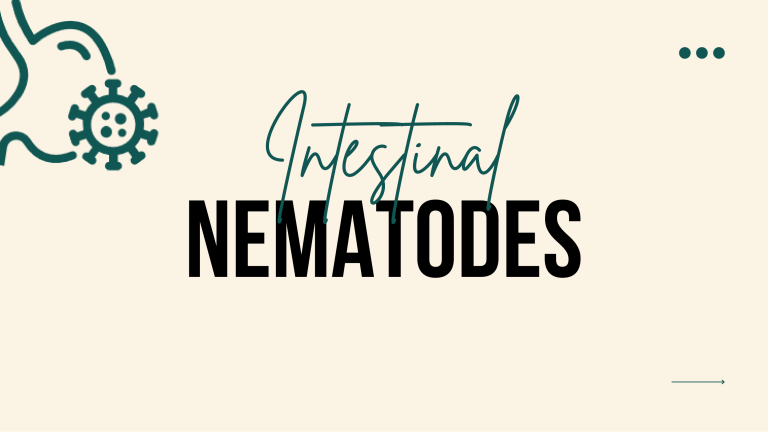
NEMATODES Introduction • The medically important nematodes can be divided into two categories according to their primary location in the body, namely, intestinal and tissue nematodes. • The intestinal nematodes include Enterobius (pinworm), Trichuris (whipworm), Ascaris (giant roundworm), Necator and Ancylostoma (the two hookworms), Strongyloides (small roundworm), and Trichinella. • Enterobius, Trichuris, and Ascaris are transmitted by ingestion of eggs; the others are transmitted as larvae Introduction • General characteristics: Also known as Intestinal Roundworms, elongated, cylindrical worms Not segmented Equipped with digestive, reproductive, excretory and nervous system Male are smaller than female Life cycle consists of three morphological forms: ova, larvae (juvenile worms), and adult Organism specific ENTEROBIUS Disease: Enterobius vermicularis causes pinworm infection Enterobiasis LIFE CYCLE: • The life cycle is confined to hu m ans • The infection is acqu ired by ingesting the worm eggs Common name – Pin worm, seatworm, society worm • The adu lt m ale and fem ale worm s live in the colon, where m ating oc c u rs Infective stage – embryonated egg Final host – man MOT – ingestion and inhalation Habitat –large intestine (caecum) • Rei nf ecti on can occu r i f they are c arri ed to the mou th b y f i ng ers af ter sc ratc hi ng the i tc hi ng ski n EGG OF E. VERMICULARIs •It is colorless. •Oval in shape and flattened on one side. •Contains a larva usually •Left: Adhesive tape preparation showing eggs of E. vermicularis recovered from anal skin. •Right: E. vermicularis egg in feces 1. Albendazole – drug of choice. 2. Mebendazole 3. Pyrantel Pamoate Familial disease. It is very contagious, can easily spread among family members or institutions. It can cause autoinfection and retro-infection – it goes to skin and back to rectum ENTEROBIUS Disease: Enterobius vermicularis causes pinworm infection Enterobiasis PATHOGENESIS & CLINICAL FINDINGS • Pe rianal pru ritu s is the m os t prom ine nt sym ptom • Pru ritu s is thou ght to be an allergic re ac tion to the presenc e of eithe r the adu lt fem ale or the eggs • Scratching predisposes to secondary bac terial infec tion and insom niA LABORATORY DIAGNOSIS • The e ggs are re c ove re d from pe rianal s kin by u s ing the S c otc h tape te c hniqu e and can be observed m ic ros c opic ally • U nlike those of other intes tinal ne m atode s , the s e e ggs are not fou nd in the s tools • T h e sm all, w h i t i sh adu lt w orm s can b e fou n d i n th e stools or n e ar th e an u s of di ap e re d ch i ldre n ENTEROBIUS Disease: Enterobius vermicularis causes pinworm infection Enterobiasis LABORATORY DIAGNOSIS Graham’s scotch adhesive tape swab (Perianal cellulose tape swab) – provides the highest percentage of positive results. • T h e sm all, w h i t i sh adu lt w orm s can b e fou n d i n th e stools or n e ar th e an u s of di ap e re d ch i ldre n Pinworm prevention and control measures practicing proper personal hygiene applying ointment or salve to the infected perianal area to prevent egg dispersal; avoiding scratching the infected area; thorough cleaning of potentially infected environmental surfaces, including linens; and treating all household members. TRICHURIS Disease: Trichuris trichiura causes whipworm infection trichuriasis Common name: whipworm INFECTIVE STAGE: EMBRYONATED EGG FINAL HOST: MAN MODE OF TRANSMISSION: INGESTION HABITAT: LARGE INTESTINE EGG OF T.TRICHIURA • It is yellow-brown Hyaline polar plug at each end; football • Has a characteristic barrel shape with a colorless protruding mucoid plug at each end • Contains a central granular mass which is the unsegmented ovum 1. Mebendazole – drug choice 2. Albendazole – alternative drug TRICHURIS LIFE CYCLE: become infective in 15 to 30 days TRICHURIS Disease: Trichuris trichiura causes whipworm infection trichuriasis PATHOGENESIS & CLINICAL FINDINGS • A l tho u gh a du l t Tri c h u ri s w o rms b u rro w th e i r h a i rl i k e a nte ri o r e nds i nto the i nte sti n a l mu c o sa , th e y d o n o t c a u se si gni fi c a nt a ne mi a , u nl i k e the ho o k w o rms • Tric hu ris m ay c au se diarrhea, bu t m os t infec tions are asym ptom atic •Trichu ris m ay also cau se rectal prolapse in c hildren with heavy infec tion LABORATORY DIAGNOSIS •Diagnosis is bas ed on finding the typic al e ggs , i. e . , barre l -s hape d (lem on -shaped) with a plu g at eac h end, in the s tool ASCARIS Disease: Ascaris lumbricoides causes ascariasis •H u ma n s a re i n f e cte d b y i n g e s ti n g worm e g g s i n f ood or wa te r con tami n ated wi th h u man f eces •Th e e ggs h atch i n th e s mall i n te s ti n e , & th e lar v ae mi gr ate th r ough th e gut wall i n to th e blood s tr e am & th e n to th e lun gs • A. lumbr icoid es is known as the " gi ant r ound wor m." Thous and s of eggs ar e laid d aily, ar e passed in The f eces, & d i f f er enti ate i nto embr yonated eggs i n war m, moist soil Common name – Giant intestinal worm/round worm Infective stage – embryonated egg Final host – man MOT – ingestion/fecal-oral route Habitat – small intestine Ascaris suum - pigs EGGS OF A. LUMBRICOIDES FERTILIZED EGG •Yellow-brown, oval or round •Shell is often covered by an uneven albuminous coat •Contains a central granular mass which is the unsegmented fertilized ovum. Decorticated egg: •This term is used to describe an egg that has no albuminous coat. A decorticated egg has a smooth shell and appears pale yellow or colorless. INFERTILE EGG •It is darker in colour and has a thinner wall •and more granular albuminous covering. •More elongated than af ertilized egg •Contains a central mass of large granules. • Usually fertilized eggs are found in feces but occasionally infertile eggs are produced by unfertilized female worms. ASCARIS Disease: Ascaris lumbricoides causes ascariasis PATHOGENESIS & CLINICAL FINDINGS LABORATORY DIAGNOSIS • The ma j o r da ma ge o c c u rs d u ri n g l a rva l mi g ra ti o n ra the r tha n fro m the p re se nc e o f the a d u l t w o rm i n the i nte sti ne • Th e p r i n c ip al si te s o f ti ssu e r e a c ti on a r e th e l u n g s , w h e r e i n f la mma tion wi th a n e o si nop hilic e x u da te o c c u r s i n r e sp onse t o l a r v a l a n ti gens • Diagnos is is u s u ally m ade m ic ros c opic ally by de te c ting e ggs in the s tools • Beca us e the adults derive their nourishm e nt from ingested food, a heavy worm burde n may contrib ut e to malnut rit io n , espec i a l ly in childre n in develo pi ng countri es • Occa s ion ally, t h e pa t ie nt s e e s a d u lt w or ms in t h e s t ool s . • Mo st i nfe c ti o ns a re a sy mp to ma ti c • A sc a r i s p n e u m o nia wi th f e v e r , c o u gh , & e o si n o p hi l ia c a n o c c u r w i t h a h e a v y lar v al b ur de n • Abdom i n al pai n an d ev en obs t r uct i on can r es ul t f r om t h e pr es en ce oF adul t wor m s i n t h e i n t es t i n E 1. Albendazole – drug of choice. 2. Mebendazole 3. Pyrantel Pamoate ASCARIS Disease: Ascaris lumbricoides causes ascariasis LABORATORY DIAGNOSIS A. Stool exam PATHOGENESIS & CLINICAL FINDINGS 1. Direct fecal smear – less sensitive • The ma j o r da ma ge o c c u rs d u ri n g l a rva l mi g ra ti o n ra the r tha n fro m the p re se– nc qualitative e o f the a d u l t w o rmdiagnosis i n the i nte sti ne 2. Kato-thick Th e p r i n c ip al si– te squantitative o f ti ssu e r e a c ti on adiagnosis r e th e l u n g s , w h e r e 3.•Kato-katz i n f la mma tion wi th a n e o si nop hilic e x u da te o c c u r s i n r e sp onse t o l a r v a l a n ti gens Beca us e the adults derive techniques their nourishm e nt from ingested food, a heavy B.• Concentration worm burde n may contrib ut e to malnut rit io n , espec i a l ly in childre n in • Occa s ion ally, t h e pa t ie nt s e e s a d u lt w or ms in t h e pi ng countri es 1.develo FECT – Fomalin ether/ethyl Concentration Technique s t ool s . Mo st i nfe c ti o ns a re Iodine a sy mp to ma tiFormaldehyde c 2. MIFCT – •Merthiolate Concentration Technique 3.• A scBrine a r i s p n efloatation u m o nia wi th f e v e r , c o u gh , & e o si n o p hi l ia c a n o c c u r w i t h a h e a v y lar v al b ur de n 1. Albendazole – drug of choice. 4. Zinc Sulfate floatation technique 2. Mebendazole 3. Pyrantel Pamoate C. X-ray (extraintestinal ascariasis to lungs) D. CBC (demonstrate eosinophilia) • Abdom i n al pai n an d ev en obs t r uct i on can r es ul t f r om t h e pr es en ce oF adul t wor m s i n t h e i n t es t i n E ASCARIS Disease: Ascaris lumbricoides causes ascariasis LABORATORY DIAGNOSIS PATHOGENESIS & CLINICAL FINDINGS • The ma j o r da ma ge o c c u rs d u ri n g l a rva l mi g ra ti o n ra the r tha n fro m the p re se nc e o f the a d u l t w o rm i n the i nte sti ne • Th e p r i n c ip al si te s o f ti ssu e r e a c ti on a r e th e l u n g s , w h e r e i n f la mma tion wi th a n e o si nop hilic e x u da te o c c u r s i n r e sp onse t o l a r v a l a n ti gens • Beca us e the adults derive their nourishm e nt from ingested food, a heavy worm burde n may contrib ut e to malnut rit io n , espec i a l ly in childre n in develo pi ng countri es • Occa s ion ally, t h e pa t ie nt s e e s a d u lt w or ms in t h e s t ool s . • Mo st i nfe c ti o ns a re a sy mp to ma ti c • A sc a r i s p n e u m o nia wi th f e v e r , c o u gh , & e o si n o p hi l ia c a n o c c u r w i t h a h e a v y lar v al b ur de n • Abdom i n al pai n an d ev en obs t r uct i on can r es ul t f r om t h e pr es en ce oF adul t wor m s i n t h e i n t es t i n E 1. Albendazole – drug of choice. 2. Mebendazole 3. Pyrantel Pamoate ASCARIS Disease: Ascaris lumbricoides causes ascariasis LABORATORY DIAGNOSIS A. Stool exam PATHOGENESIS & CLINICAL FINDINGS 1. Direct fecal smear – less sensitive • The ma j o r da ma ge o c c u rs d u ri n g l a rva l mi g ra ti o n ra the r tha n fro m the p re se– nc qualitative e o f the a d u l t w o rmdiagnosis i n the i nte sti ne 2. Kato-thick Th e p r i n c ip al si– te squantitative o f ti ssu e r e a c ti on adiagnosis r e th e l u n g s , w h e r e 3.•Kato-katz i n f la mma tion wi th a n e o si nop hilic e x u da te o c c u r s i n r e sp onse t o l a r v a l a n ti gens Beca us e the adults derive techniques their nourishm e nt from ingested food, a heavy B.• Concentration worm burde n may contrib ut e to malnut rit io n , espec i a l ly in childre n in • Occa s ion ally, t h e pa t ie nt s e e s a d u lt w or ms in t h e pi ng countri es 1.develo FECT – Fomalin ether/ethyl Concentration Technique s t ool s . Mo st i nfe c ti o ns a re Iodine a sy mp to ma tiFormaldehyde c 2. MIFCT – •Merthiolate Concentration Technique 3.• A scBrine a r i s p n efloatation u m o nia wi th f e v e r , c o u gh , & e o si n o p hi l ia c a n o c c u r w i t h a h e a v y lar v al b ur de n 1. Albendazole – drug of choice. 4. Zinc Sulfate floatation technique • Abdom i n al pai n an d ev en obs t r uct i on can r es ul t f r om t h e pr es en ce oF adul t wor m s i n t h e i n t es t i n E 2. Mebendazole 3. Pyrantel Pamoate ASCARIS Disease: Ascaris lumbricoides causes ascariasis LABORATORY DIAGNOSIS PATHOGENESIS & CLINICAL FINDINGS C. X-ray (extraintestinal ascariasis to lungs) D. CBC (demonstrate eosinophilia) • The ma j o r da ma ge o c c u rs d u ri n g l a rva l mi g ra ti o n ra the r tha n fro m the p re se nc e o f the a d u l t w o rm i n the i nte sti ne • Th e p r i n c ip al si te s o f ti ssu e r e a c ti on a r e th e l u n g s , w h e r e i n f la mma tion wi th a n e o si nop hilic e x u da te o c c u r s i n r e sp onse t o l a r v a l a n ti gens • Beca us e the adults derive their nourishm e nt from ingested food, a heavy worm burde n may contrib ut e to malnut rit io n , espec i a l ly in childre n in develo pi ng countri es • Mo st i nfe c ti o ns a re a sy mp to ma ti c • A sc a r i s p n e u m o nia wi th f e v e r , c o u gh , & e o si n o p hi l ia c a n o c c u r w i t h a h e a v y lar v al b ur de n • Abdom i n al pai n an d ev en obs t r uct i on can r es ul t f r om t h e pr es en ce oF adul t wor m s i n t h e i n t es t i n E • Occa s ion ally, t h e pa t ie nt s e e s a d u lt w or ms in t h e s t ool s . ANCYLOSTOMA & NECATOR Disease: Ancylostoma duodenale (Old World hookworm) & Necator americanus (New World hookworm) cause hookworm infection Necator Americanus – Human hookworm, New world hookworm Ancyclostoma braziliense -Cat hookworm Ancyclostoma caninum– Dog hookworm Ancyclostoma duodenale– Human hookworm, Old world hookworm Habitat: small intestine Diagnostic stage: ova Infective stage: L3 larva EGG OF HOOKWORM(N.AMERICANUS OR A.DUODENALE) • Note: If the specimen is more than 12 hours old, a larva may be seen inside the egg • If the feces is more than 24 hours old, the larva may hatch and must then be differentiated from a Strongyloides larva • LEFT: SEGMENTED. • • Right: Embryonated • A N C Y L O S T O M A & N E C A T O R L I F E c y c l e ANCYLOSTOMA & NECATOR Disease: Ancylostoma duodenale (Old World hookworm) & Necator americanus (New World hookworm) cause hookworm infection PATHOGENESIS & CLINICAL FINDINGS • The major damag eis du e to the loss of b looda t the s ite of attachmen t in the small intestine. Up to 0.1 to 0.3 mL per worm can b e lost per day 1.Creeping eruptions or Cutaneous Larval Migration (CLM) - extraintestinal larval migration or due to skin penetration 1.DUE TO ADULT: epigastric pain, diarrhea, malnutrition, severe anemia-microcytic, hypochromic type, IDA •" 1.DUE TO LARVA: WAKANA Disease - pneumonitis coolic itch, dew itch, ground itch. • Pneumonia with eosinophilia can be seen during larval migration through the lungs ANCYLOSTOMA & NECATOR Disease: Ancylostoma duodenale (Old World hookworm) & Necator americanus (New World hookworm) cause hookworm infection LABORATORY DIAGNOSIS 1. Stool exam - DFS 2. Culture technique: Harada Mori Technique • D i a g n os i s i s m a d e m i c r o s c o p ic ally by o bs e r v i n g t h e e g g s i n t h e s t o o ls • Occult blood in the stools is frequent • Eosinophi li a i s t y pi c al Mebendazole, Albendazole STRONGYLOIDES Disease: Strongyloides stercoralis causes strongyloidiasis • S . s tercorali s h as two di s ti n ct li f e cycles , on e wi th i n th e h u man body & th e oth er f ree - li vi n g i n th e s oi l Strongyloides stercoralis Common name: thread worm FH: man Habitat: small intestine Diagnostic stage: Rhabditiform (L1) larva Infective stage: L3 Source of infection: STH FEMALES ARE CAPABLE OF PARTHENOGENESIS Favorable conditions: Free-living Unfavorable conditions: Parasitic STRONGYLOIDES (LIFE CYCLE) STRONGYLOIDES Disease: Strongyloides stercoralis causes strongyloidiasis PATHOGENESIS & CLINICAL FINDINGS • M o s t p at i e nt s ar e as y m p tom atic, e s p e cially t ho s e w i t h a l o w w o r m bu r d e n • Ad u l t f e m al e w o r m s i n t he w al l o f t he s m al l i nt e s tine can cau s e i nfl amm ation, r e s u lting i n wat e r y d i ar r hea • In aut oinfect ion, t he penet r at ing l ar v ae may caus e s ufficient damage t o t he int es t inal mucos a t hat s eps is caus ed by ent er ic bact er ia can occur • Larvae in the lungs can produce apneumonitis similar to that caused by Ascaris • Pruritus can occur at the site of larval penetration of the skin, as with hook worm 1. Cochin China Diarrhea or Vietnam Diarrhea 2. Honey comb ulcer 3. Skin allergy due to larval penetration 4. Larval migration --> pneumonia LARVA OF S.STERCORALIS • Larva of S. stercoralis as seen with 10x objective S.STERCORALIS vs. hOOkwOrm S.STERCORALIS vs. hOOkwOrm STRONGYLOIDES Disease: Strongyloides stercoralis causes strongyloidiasis A. B. C. D. Stool Exam >Direct Fecal Smear >Kato-thick >Kato-katz Concentration techniques LABORATORY DIAGNOSIS • D i a g n o s i s d e p e n d s o n f i n d i n g la r v a e , r a th e r th a n e g g s , i n th e s to o l • As with many nematode infections in which larvae migrate through tissue, eosinoph il ia can be striking Mebendazole, Albendazole, Thiabendazole Trichinella capillaria capillaria NEMATODES Wuchereria bancrofti Brugia malayi Brugia timori Loa loa Mansonella spp. Onchocerca volvulus Dirofilaria spp. VECTORS Mosquitos(Anopheles, Culex, Aedes) Mosquitos(Anopheles, Culex, Aedes) Mosquitos(Anopheles, Culex, Aedes) Chrysops or Mango fly Culicoides gnats of bitting midges Black fly of buffalo gnat Blackflies
